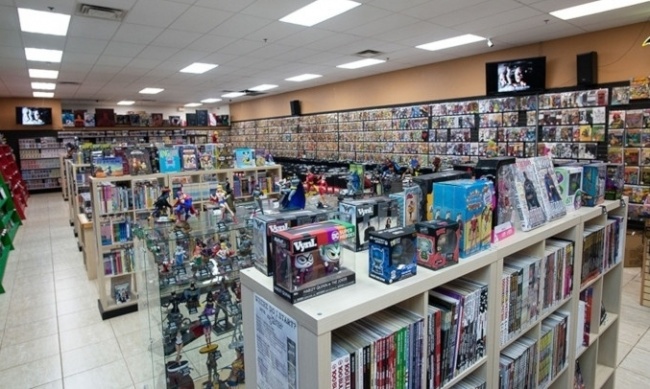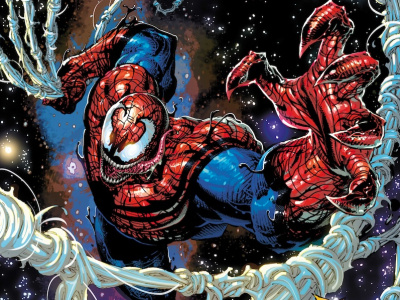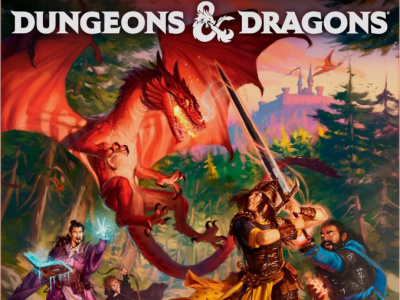I’ve been in comic retail for nearly 37 years. I’ve always felt there was a great future for comics though my concerns for how we sell comics has grown more urgent in recent years. I don’t think publishing will go away, but comic stores as we know them are showing signs of stress due to multiple factors. We’re on the cusp of either a renaissance of new ideas on how to sell comics, or we’re facing an extinction level event for comic stores. Last year I raised both eyebrows and blood pressure by outlining some changes that my stores were going to make in the face of abusive and predatory publishing practices. I’m happy to say that a lot of publishers saw the same writing on the wall as I and so many of my retailer colleagues, and eagerly jumped on board in an effort to bring up sales. We saw more returnable comic in 2019 than the previous bunch of years and it’s helped put books on the stands that would have otherwise been without. Boom! Studios was an innovative leader in this and for those who missed the announcement, Boom! jumped from the #6 publisher to the #4 publisher at the end of 2019. They’re doing something right – a lot of things right.
Before I get into some of the nuts and bolts of where I see the industry, I’d like to preface it with acknowledgment that many stores are doing fine and many are doing quite well. My concerns for the industry are that even the biggest boats bottom out when the waters get too shallow. If we lose another 500 stores, can publishers afford to publish at 3.99 or even 4.99? I have no doubt that math has been done and it’s not pretty.
I did a poll recently among comic retailers and asked them to take their 2018 total income and put it in Los Angeles dollars so we’d all be comparing the same apples to apples. What this showed was the standard of living comic retailers exist in once the bills at the store are paid. The sad thing is, 49+% live at HUD Very Low or lower income levels. Only 15% are above median income. When I opened, I was making somewhere in the range of half minimum wage for about 3 years before things started leveling out. After 37 years, those and other struggles have paid off to create a decent living. But in too many cases, store owners open for 20 and more years are living a pretty low standard of living.
A recent data breach of Marvel numbers from Diamond comics made the rounds a month or so ago. It’s been widely reported and analyzed at this point. The numbers are only a snapshot of one publisher but as Marvel is the largest publisher, the numbers suggest there are a lot of stores just making it. Another thing it shows is that Coliseum of Comics is the largest Brick & Mortar-only comic chain selling Marvel comics. I had the benefit of starting in a different era in a market not consumed by online discounting. It was also a market that first sold stories, not covers, events, or a litany of one-shot cash grabs that did nothing to encourage further reading. That was a market that allowed me to grow. When I opened there were new comics, a precious few collected editions, and back issues. We could afford to put comics on the stands because the cost was reasonable in comparison to economics of the time and we weren’t guessing at potential sales for hundreds of books like we are going into 2020.
Many comparisons have been made between Then and Now when it comes to comics vs. minimum wage vs disposable income. Here’s some perspective to move toward the point rather than the rambling of an “in my day” sort of thing. In 1983, minimum wage was 3.35, or 5 ½ times the cost of a 60 cent comic. In 2019, minimum wage is 7.25 though for the sake of not skewing numbers to make a point, we’ll call it $11 an hour. New comics, per the November 2019 order form, averaged $4.39 making the number about 2 ½ comics per hour worked. But the end user component isn’t the biggest hurdle to success going into 2020.
In 1983, I could order a few extras for the stands. The back issue market ensured a long tail for sales if a book didn’t sell off the stands. Using the resources from our friends at Mycomicshop.com, in Nov 1983, a total of 104 American comic books shipped with an average price point of .78. 11 total first issues, no variant covers. Time jump to November 2019, Coliseum ordered 769 titles/covers (read that part again). 53 titles are #1s encompassing 140(!) covers. There were dozens of other comics and covers offered that we passed on entirely.
PROBLEM ONE
Here’s where these elements tie together. As costs and the number of titles have risen and surpassed the minimum wage gap, it’s become exponentially more expensive to stock new comics. Remember that stat above about 49% or retailers living on very low or lower income? That group is the group with the least information about a book and the highest cost to put it on our shelves HOPING it will sell. And hoping we ordered the cover that each customer wants. And hoping the other 750 covers sell as well. One copy of each book & cover for Nov. is $3327. Batman and X-Men sell many more than a single copy. Throw in 9 covers on Marvel title #74 or a recent 100+ covers for 7 titles(!?!) from Dynamite and it starts adding up quickly. Too quickly to stock every cover of every book. This is the drive-home point: retailers at large do not have the financial resources to stock the shelves with every option hoping we picked the right cover. I have some pretty savvy comic fans shopping at my stores who know what they like and let us know. I also have a lot of walk-in folks who are looking for something after FOC orders have gone in.
The bottom line is the people in the comic industry who can least afford it are expected to take the biggest risks.
We’ve had some traction to help on this front this past year. Returnability has allowed retailers to stock the stands and see where the ceiling is for new titles. I asked for more of this last year and there’s been some shining moments by quite a few publishers with new returnability mirroring much of what Boom! pioneered a few years ago.
SOLUTION ONE
Publishers, be our partners. Yeah, nice word to throw around when we’re all feeding from the same leaking trough and you have corporate taskmasters demanding their large share of the bank account. We’re all on the same boat and when (not if) too many stores go under or stop stocking anything for the stands, we’ll hit a point of not enough numbers to continue publishing at even $4.99. Returnability is one solution, even with minimums to qualify so that you’re helping us maximize eyes on your newest product.
SOLUTION TWO
Overships. Let retailers sign up for automatic overships and we’ll pay shipping and if the overship sells, we’ll pay for those as well. This lets you decide how many you want out there and limits your risk rather than open-order returnable books.
PROBLEM TWO
We’ve become the showrooms for so many online discounters that we’re hosting viewing parties rather than sales events. Check it out here, buy it online. This is nothing new but it’s not going to get better. Overall, according to CNBC, holiday sales rose 3.4% over 2018. Online sales rose 18.8%. The recent data leak shows that the top three accounts are online discounters and are larger than the next 18, which includes sub-distributors; and larger than the bottom 1100 accounts combined. Discounting is an age-old solution to beating the competition, but the downside is that people start to view your product as not worth the price printed on it.
Publishers, you failed to safeguard the value of your properties and now they are perceived as having fractional value. Now comic stores are paying the price for your short-term thinking. Trade paperbacks aren’t worth cover price to too many fans as they’ve been mentally price-adjusted to 35%-40% off retail. A common question is “How much are your trades” while the customer is standing in the air conditioning looking at the price, not believing that anyone would have the audacity to charge the price printed on the book. Has anyone noticed that as more sales have gone online, fewer people are reading traditional comics? The daily comic convention hosted in comic stores around the country have fewer customers. The excitement of the new comic day is getting fewer participants and the alternative, the Internet, is a troll-tastic place where nothing is good.
I know, I know, the online stores are catering to people who live in areas without comic stores. Please stop pushing that nonsense. If you’re the only available option, you wouldn’t have to discount.
The usual pushback is “Well why don’t you sell online?” Fair question though it ignores the key problem that your books aren’t viewed as worth cover price. If that doesn’t hit you in the head like a Looney Tunes mallet then you need to reread that a few times.
Hard choices ahead.
SOLUTION THREE
MAP. Minimal Advertised Pricing. Yup. Hard choices. So I’ll give you an easier path.
SOLUTION FOUR
Comic Store Exclusives. A thicker cover stock, a few added pages, and a contractual obligation not to sell below X% of cover price for 60 or 90 days. Can’t be done? Not true. MAP is common in the game industry. Can’t be policed? We have fewer problems with people selling comics on Tuesday – how many stores have been caught breaking street date? – so allot some of that to a web search.
One caveat to this: Just because it’s exclusive doesn’t mean it’s good. Quality stories that matter, and quality art sells. Short term one-off publishing is a diminishing return game.
THE PROMISE
My stores were more profitable in 2019 due to many of the changes I made following last year’s letter about the industry. We’re making more changes this year and adding a promise to the list.
What I’m offering publishers:
- Well lit, stocked, clean stores.
- A uniformed and knowledgeable staff who passionately loves comics.
- Full-facing new comic displays spanning hundreds of linear feet in every store.
- Long store hours for mass-market availability.
- In-store promotional materials done at our cost.
- Thousands of dedicated customers each and every week looking for comics.
Every other industry, including the publishing industry, buys rack space and in-store placement. Payment is usually via better discounts, additional product, or advertising. I’m not charging to put your book on the stands in my professional stores. But here’s the deal.
First issues:
If you offer returnability on a first issue, I will order a minimum of 10 copies per store. That’s my promise to you. I’ll display them on my full cover racks in my well-lit, clean stores with happy and knowledgeable staff. And here’s a huge bonus: your book will be seen by thousands of devoted comic fans.
As a returnable bonus, I’ll stock the book for 5 weeks on my stands vs my traditional 4 weeks.
I will be returning anything over the mark that puts me under 90% sell-through.
This offer is revoked if you offer more than 2 at-retail covers. And you get 10 copies minimum if you offer one or two covers; I’m buying comics, not covers.
#2 or beyond:
I’ll order a minimum of 5 copies per store as long as they’re returnable. If sales don’t bear that out after a few issues, I won’t waste your resources by ordering unsellable books but I guarantee at least one copy for the stands.
Returnable doesn’t mean it’s good or that it will sell but for my stores, I guarantee you’ll sell more by having a copy/copies on the stands than preorder only. It’s still a cashflow issue so let’s all be judicious.
Here’s the flipside of the deal for publishers still abusing FOC and doing predatory publishing in 2020.
Let’s define “Predatory Publishing.” Predatory Publishing is doing any of the following without returnability or a massively huge discount above “max” discount.
- If I have to order #2 before I see sales data on #1, you’re pushing all the risk to me. This also goes for any book we’re ordering the next issue without data on the previous issue.
- If it’s a one-shot or worse, a series of one-shots bookended by one-shots.
- If it’s weekly. Period.
All the X-Men relaunch books were huge failures in the potential field as we had to order 2-3 issues ahead, undercutting the value of FOC. With no serious overprints, we lost customers. To be clear, we did not lose sales as customers spent money on other projects instead. If you don’t get behind your project financially, then I can’t afford to get behind it either.
A new title without returnability or a significant discount won’t be stocked deeply. My customers have hundreds of options and only a miniscule percentage of them have bottomless wallets.
We’ll order for subscriptions only if we’re ordering with no data on a previous issue, bi-weekly schedule excepted with some mitigating factor attached. Bi-weekly mini-series or weekly mini-series get you subs-only orders. None for the stands. Recent history shows it’s not worth the gamble, even with conservative orders for the stands.
Publishers, you have your numbers to make. As retailers, we have ours. It’s time to consider if the local comic store is in your future plans.
I look forward to working with every publisher to raise sales in 2020.
The opinions expressed in this column are solely those of the writer, and do not necessarily reflect the views of the editorial staff of ICv2.com.









